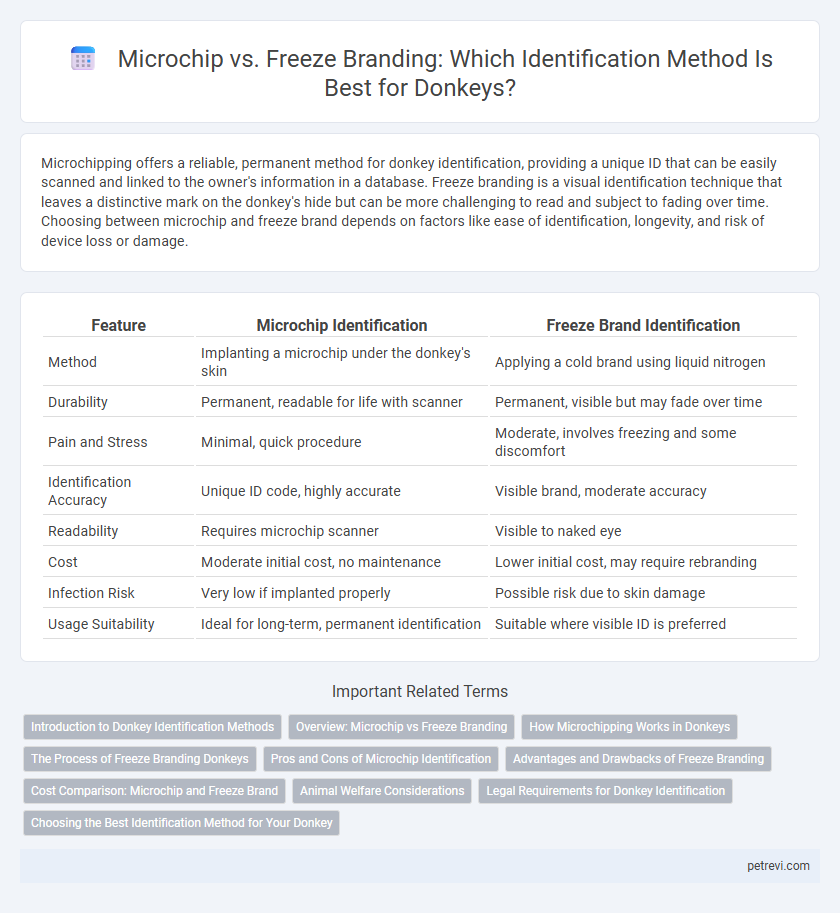Microchipping offers a reliable, permanent method for donkey identification, providing a unique ID that can be easily scanned and linked to the owner's information in a database. Freeze branding is a visual identification technique that leaves a distinctive mark on the donkey's hide but can be more challenging to read and subject to fading over time. Choosing between microchip and freeze brand depends on factors like ease of identification, longevity, and risk of device loss or damage.
Table of Comparison
| Feature | Microchip Identification | Freeze Brand Identification |
|---|---|---|
| Method | Implanting a microchip under the donkey's skin | Applying a cold brand using liquid nitrogen |
| Durability | Permanent, readable for life with scanner | Permanent, visible but may fade over time |
| Pain and Stress | Minimal, quick procedure | Moderate, involves freezing and some discomfort |
| Identification Accuracy | Unique ID code, highly accurate | Visible brand, moderate accuracy |
| Readability | Requires microchip scanner | Visible to naked eye |
| Cost | Moderate initial cost, no maintenance | Lower initial cost, may require rebranding |
| Infection Risk | Very low if implanted properly | Possible risk due to skin damage |
| Usage Suitability | Ideal for long-term, permanent identification | Suitable where visible ID is preferred |
Introduction to Donkey Identification Methods
Donkey identification methods primarily include microchipping and freeze branding, each offering distinct advantages for long-term animal management. Microchipping provides a permanent, scannable ID embedded under the skin, minimizing the risk of tampering or fading over time. Freeze branding creates a visible, easily recognizable mark using extreme cold to alter the skin pigment, allowing for quick identification without the need for special equipment.
Overview: Microchip vs Freeze Branding
Microchip identification provides a permanent, scannable implant with unique numerical data registered in global databases, ensuring precise donkey tracking and ownership verification. Freeze branding uses a cold iron to create a distinct, visually identifiable mark on the donkey's skin, offering a less invasive but more easily observable alternative. Both methods are widely accepted for donkey identification, with microchips favored for their tamper-resistant qualities and freeze branding valued for immediate visual recognition in the field.
How Microchipping Works in Donkeys
Microchipping in donkeys involves implanting a small, biocompatible RFID chip under the skin, typically in the neck area, which provides a unique identification number readable with a specialized scanner. This method offers a permanent and tamper-proof form of identification, essential for tracking ownership, veterinary care, and theft prevention. Unlike freeze branding, microchips are less invasive, do not alter the animal's appearance, and are widely accepted by animal registries and veterinary organizations.
The Process of Freeze Branding Donkeys
Freeze branding donkeys involves chilling a branding iron with liquid nitrogen or dry ice to approximately -196degC before applying it to the animal's skin for 45-90 seconds, causing destruction of pigment-producing cells and resulting in a white hair regrowth identification mark. This process requires precise timing and proper hair clipping to ensure clean, legible brands that last for the donkey's lifetime. Freeze branding is a reliable, painless method that offers visible identification without the risk of microchip migration or electronic failure common in microchip identification.
Pros and Cons of Microchip Identification
Microchip identification for donkeys offers a permanent, tamper-proof method that allows for quick and reliable scanning, improving traceability and theft prevention. However, microchips can sometimes migrate from the injection site, complicating scanning, and require specialized equipment and trained personnel to read, which may not be readily available in all regions. Unlike freeze branding, microchipping is minimally invasive with no visible marks, but it does not provide a visible external identifier useful for visual inspections.
Advantages and Drawbacks of Freeze Branding
Freeze branding for donkey identification offers advantages such as permanent, easily visible marks that do not cause discomfort or infection compared to hot branding. It provides a reliable method for long-term identification even as the donkey's coat grows back, though it may be less effective on dark-coated donkeys due to limited contrast. Drawbacks include the requirement for specialized equipment, potential for inconsistent results if improperly applied, and slower application process compared to microchipping.
Cost Comparison: Microchip and Freeze Brand
Microchip identification for donkeys typically costs between $30 and $50, including implantation and registration fees, while freeze branding ranges from $60 to $120 depending on location and equipment used. Microchipping offers a lower initial cost but may require periodic scanning to confirm identity, whereas freeze branding involves a higher upfront investment with a permanent visible mark. Both methods provide reliable identification, but microchips offer a cost-effective solution for large-scale or long-term donkey management.
Animal Welfare Considerations
Microchip identification for donkeys offers a permanent, minimally invasive method that reduces stress and eliminates the risk of skin damage associated with freeze branding. Freeze branding, while visually effective, can cause discomfort and potential tissue injury due to the application of extreme cold, raising animal welfare concerns. Veterinary professionals often recommend microchipping as the preferred identification technique to ensure accurate tracking without compromising donkey health or well-being.
Legal Requirements for Donkey Identification
Microchip and freeze branding are both recognized methods for donkey identification, but microchipping is increasingly favored due to its compliance with international legal standards and ease of traceability. Legal requirements often mandate microchips for official registration and transport documentation, ensuring tamper-proof, permanent identification. Freeze branding, while still accepted in some jurisdictions, may face limitations regarding visibility and standardization compared to microchips in legal contexts.
Choosing the Best Identification Method for Your Donkey
Microchip identification offers a permanent, tamper-proof solution with unique numerical codes readable by scanners, ensuring reliable donkey tracking. Freeze branding provides a visible, long-lasting mark that is less prone to fading compared to traditional hot branding, aiding quick visual identification. Choosing between microchip and freeze brand methods depends on the need for discreet identification versus easy, on-site visual confirmation in donkey management.
Microchip vs Freeze brand for Donkey Identification Infographic

 petrevi.com
petrevi.com